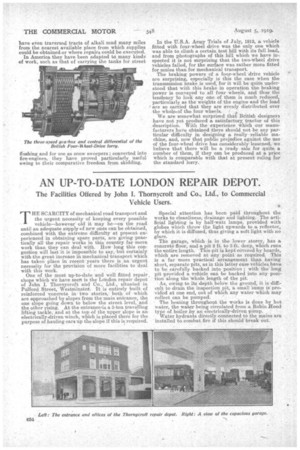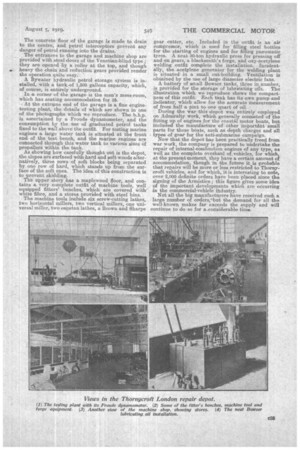AN UP-TO-DATE LONDON REPAIR DEPOT.
Page 12

Page 13

If you've noticed an error in this article please click here to report it so we can fix it.
The Facilities Offered by John I. Thornycroft and Co., Ltd., to Commercial Vehicle Users.
THE SCARCITY of mechanical road transport and the urgent necessity of keeping every possible vehicle—however old it may be—on the road until an adequate supply (if new, ones can be obtained, combined with the extreme difficulty at present experienced in obtaining spare parts, are giving practically all the repair works in this country far more work than they can deal -with. How long this congestion will last-it is impossible to say, but certainly with the great increase in mechanical transport which has taken place in recent' years there is an urgent necessity for the provision of more facilities to deal with this work.
One of the most up-to-date and well fitted repair. shops which We have seen is the London repair depot of John L Thorn_ycroft and Co., lit& situated in Pulford. Street, Westrdinstel. it is entirely built of reinforced -concrete in two stories,both of which are approached by slopes from the main-entrance, the one slope going down to below the street level, and the other rising. At the entranceis a 3-ton travelling lifting tackle and at the top of the upper slope is an electrically-dkven winch, which is placed there for the purpose of hauling cars up the slope if this is required.
Special attention has been paid throughout the works to cleanliness, drainage and lighting. The artificial lighting is by half-watt lamps, provided with globes which throw the light upwards to a reflector, by which it is diffused, thus giving a soft light with no glare.
The garage, which is in the lower storey, has a concrete floor, and a pit 2 ft. to 3 ft. deep, which runs the .entire length. This pit is kept covered by boards, which are removed at any point 'asrequired. This is a far more practical arrangement than having short, separate pits, as in this latter case vehicles have to be carefully backed into position ; with the long pit provided a vehicle can be backed into any position along the whole length of the pit.
As, owing to its depth below the ground, it is difficult to drain the inspection pit, a small 'sump is provided at one end, out of which any water which may collect can be pumped.
The heating throughout the works is done by hot water, the water being circulated from a Robin Hood. type of boiler by an electrically-driven pump. Water hydrants directly connected to the mains are installed to corabat fire if this should break •out. The concrete floor of the garage is made to drain to the centre, and petrol interceptors prevent any danger of petrol running into the drains. The entrances to the garage and machine shop are provided with steel doors of the Venetian-blind type ; • they are opened by a roller at the top, and though heavy the chain and reduction gears provided render the operation quite easy.
A Bywater hydraulic petrol storage system is installed, with a tank of 1,500 gallons capacity, which, of course, is entirely underground. In a corner of the garage is the men's mess-room, which has seating accommodation for 36.
At the extreme end of the garage is a fine enginetesting plant, the details of which are shown in one of the photographs which we reproduce. The b.h.p. is ascertained by a Froude dynamometer, and the consumption by the use of graduated petrol tanks fixed to the wall above the outfit. For testing marine engines a large water tank is situated at the front end of the test bench, and the marine engines are connected through this water tank to various sizes Of propellers within the tank. As showing how carefully thought out is the depot, the slopes are surfaced with hard and soft woods alternatively, three rows of soft blocks being separated by one row of hard, which stands up from the surface of the soft ones. The idea of this construction is to prevent skidding.
The upper story has a maplewood floor, and contains .a very complete outfit of machine tools, well
• equipped fitters' benches, which are covered with white fibre, and a stores provided with steel bins. The machine tools include six screw-cutting lathes, two horizontal millers, two vertical millers, one universal miller, two capstan lathes, a Brown and Sharpe gear cutter, etc. Included in the outfit is an • air compressor, which is used for filling steel bottles for the starting of engines and for filling pneumatic tyres. A neat 30-ton hydraulic press for pressing offend on. gears, a blacksmith's forge, and oxy-acetylene welding outfit complete the installation. Incidentally, the acetylene generator for the welding plant is situated in a small •out-building. Ventilation is obtained by the use of large diameter electric fans.
A battery of small Bowser tanks, three in. number, is provided for the storage of lubricating oils. The illustration which we reproduce shows the compactness of this outfit. Each tank has its own pump and indicator, which allow for the accurate measurement of from half a pint to one quart of oil.
During the war this depot was entirely employed on Admiralty Work, which generally consisted of the fitting up of engines•for the coastal motor boats, but included the manufacture of Other iraportAnt small parts for these boats, such as depth charges and all types of gear for the anti-submarine campaign. Now that the depot has been practically freed from war work, the company is prepared to undertake the repair of internal-combustion engines of any type, as well as the cornplete overhaul of,vehicIes, for which, at the present moment, they have a certain amount of accommodation, though in the future it is 'probable that repairs will be more or less restrictea to Thornycroft vehicles, and for which, it is interesting to note, over 2,000 definite orders have been placed since the signing of the Armistice; this figure gives some idea of the important developments which are oecurring in the commercial-vehicle industry. Not all the big manufacturers have received such a large numiber of orders ,'but the demand for all the well-known makes far exceeds the supply and will continue to do , so for a ;considerable time..






















